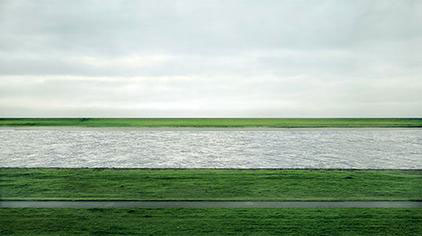The Rhine is often thought of as the inspiration for the world’s great fairy tales and poetry – but “Rhine romanticism” swept the art world at the end of the 18th century thanks to the iconic riverscapes and sites along the breadth of the river. The Rhine is extremely photogenic (as seen above in a guest photo taken on a Tauck Rhine river cruise) – and is as well known as the inspiration for photography and prints as art, as you’ll discover with the story of “Stripes of Green and Gray.”
 In 2011, Andreas Gursky’s photo Rhein II (at right) was sold for $4,338,500 at a Christie’s auction – breaking the record for the most expensive photograph ever sold at auction. The German photographer is renowned in the photography world, and has photos on display from London’s Tate Modern to the Museum of Art in New York City. He has sold other photos at auction for considerable sums – but this photo, and this amount, broke the record for the most expensive photograph ever sold at auction.
In 2011, Andreas Gursky’s photo Rhein II (at right) was sold for $4,338,500 at a Christie’s auction – breaking the record for the most expensive photograph ever sold at auction. The German photographer is renowned in the photography world, and has photos on display from London’s Tate Modern to the Museum of Art in New York City. He has sold other photos at auction for considerable sums – but this photo, and this amount, broke the record for the most expensive photograph ever sold at auction.
Francis Outred, who was the head of Europe in post-war and contemporary art at Christie’s, told NPR: “The Rhine is ‘one of the most symbolic motifs in German art; it runs through Andreas Gursky’s hometown of Dusseldorf, as well as six European countries, and has inspired art for centuries. This photo is exceptional: “One of the most powerful and profound depictions ever to be created of the Rhine, the photo’s unique scale draws an ineffable link to the actual natural landscape, inviting the viewer to cross over into its vivid picture plane.”
The photo measures 6 x 11 feet and symbolizes Gursky’s unique process of combining film and digital processes. According to the Tate, “The Rhine II was produced in an edition of six; Tate owns the fifth in the series. This large colour photograph depicts a stretch of the river Rhine outside Düsseldorf. The image is immediately legible as a view of a straight stretch of water, but it is also an abstract configuration of horizontal bands of colour of varying widths. The horizon line bisects the picture almost exactly in the middle. Above it the overcast sky is a blue-grey. In the bottom half of the image, the river is a glassy, unbroken band between green stripes of grass. At the bottom of the picture in the immediate foreground is a narrow path. Below it is another thin band of manicured green grass.”
“Gursky works with a medium format camera, taking pictures which he then scans into a computer where he can manipulate them. His aim in using digital technology is not to create fictions but rather to heighten the image of something that exists in the world. He has described the genesis of this work, saying, ‘there is a particular place with a view over the Rhine which has somehow always fascinated me, but it didn’t suffice for a picture as it basically constituted only part of a picture. I carried this idea for a picture around with me for a year and a half and thought about whether I ought perhaps to change my viewpoint … In the end I decided to digitalise the pictures and leave out the elements that bothered me.’ Gursky digitally erased buildings on the far side of the river from his picture. Gursky’s photograph is a detached comment on the sublime connotations of Romanticism.”
And yet to most onlookers, as reported by several critics and publications, the prized Rhine photo is summed up simply as “stripes of green and gray”…
Take a look below at some fascinating documentaries profiling not only Andreas Gursky, but other art and artists inspired by the Rhine and rivers of Europe:
Exploring…






More Stories
Backpacking Journeys: Adventure Awaits on Every Path
Backpacking Journeys: Go Further, Explore Deeper
Backpacking Journeys: Find Solitude in Nature’s Beauty